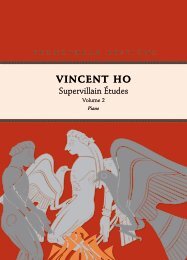String Quartet No.1: The Awakening (Preview)
by Christos Hatzis | String Quartet and Digital Audio
by Christos Hatzis | String Quartet and Digital Audio
Create successful ePaper yourself
Turn your PDF publications into a flip-book with our unique Google optimized e-Paper software.
<strong>String</strong> <strong>Quartet</strong> <strong>No.1</strong>: <strong>The</strong> <strong>Awakening</strong> (1994)<br />
<strong>String</strong> <strong>Quartet</strong> <strong>No.1</strong>: <strong>The</strong> <strong>Awakening</strong> sees the string quartet augmented by the incorporation<br />
of an accompanying digital audio part that draws out the inherent musicality of both Inuit<br />
throat singing and locomotives. Hatzis samples these sounds in ways that can give the<br />
impression of vague memories materialising and then receding, while in other moments they<br />
come into sharp focus, the rhythmic nature of these sound sources becoming a driving force<br />
alongside the quartet as the piece accumulates momentum and urgency. At other times the<br />
quartet’s material is underpinned by synthesizer textures that appear in turn as cavernous<br />
low chords, playful twinkling, or mutated simulations of ricochet bowing that extend the<br />
timbral palette of the live players. <strong>The</strong> emotional terrain of the work ranges from poignant<br />
to hostile to light-hearted, with these shadings realised through demanding but captivating<br />
string writing that employs fluid, microtonal glissandi, forceful tremolo bowing and<br />
expressive, mournful melodic lines. After trading statements with the quartet in the work’s<br />
energetic climax, the digital audio departs, leaving the unaccompanied players to see out a<br />
final extended passage that reprises the work’s sombre thematic material.<br />
<strong>String</strong> <strong>Quartet</strong> <strong>No.1</strong>: <strong>The</strong> <strong>Awakening</strong> was commissioned and premiered by the Smith<br />
<strong>Quartet</strong>, with funding support from the Canada Council and the London Arts Board (UK).<br />
<strong>The</strong> premiere performance was given at St Alsege Church, Greenwich, London, UK on 11<br />
June 1994. It has also been recorded by the St Lawrence <strong>Quartet</strong> for the EMI Classics album<br />
Christos Hatzis: <strong>Awakening</strong>.<br />
<strong>The</strong> composer writes:<br />
<strong>String</strong> <strong>Quartet</strong> <strong>No.1</strong>: <strong>The</strong> <strong>Awakening</strong> was a turning point in my career as a composer. It was<br />
composed at a time in my life which could best be described as a crossroads — musical<br />
and otherwise. <strong>The</strong> two most prominent and immediately recognizable references in this<br />
work are Inuit throat singers and locomotive engines. <strong>The</strong> former had been haunting<br />
me since 1992, the year I worked on a CBC radio documentary, <strong>The</strong> Idea of Canada. It<br />
was then that I first became exposed to the chanting and vocal games of the native<br />
PE117 – v


















